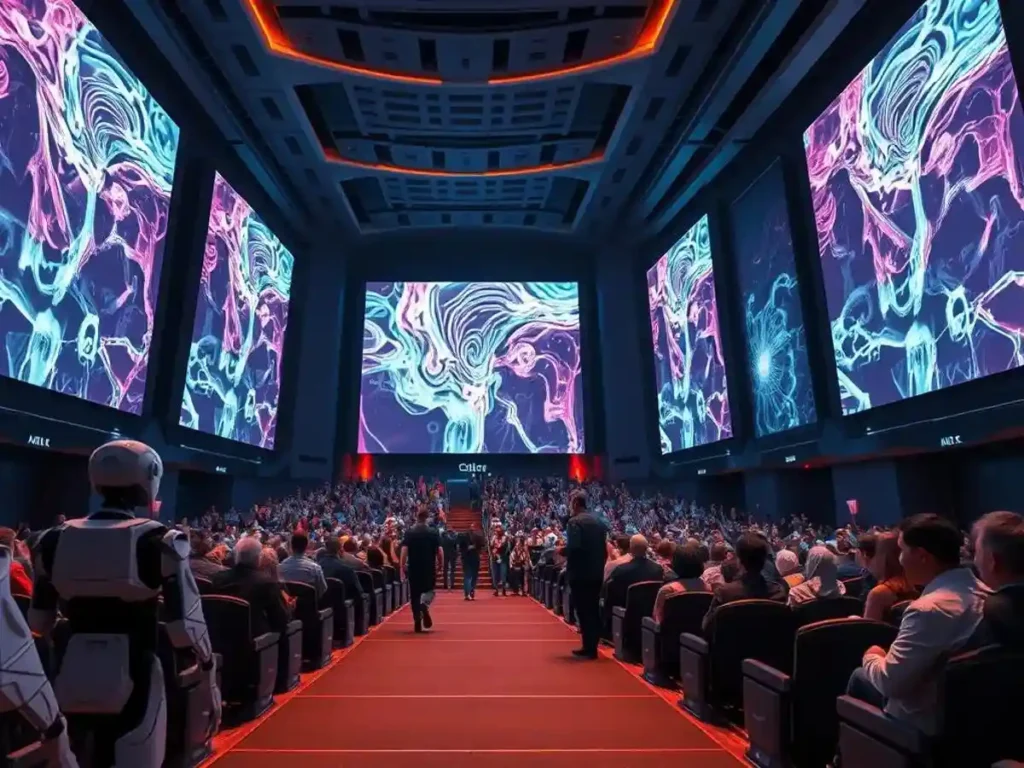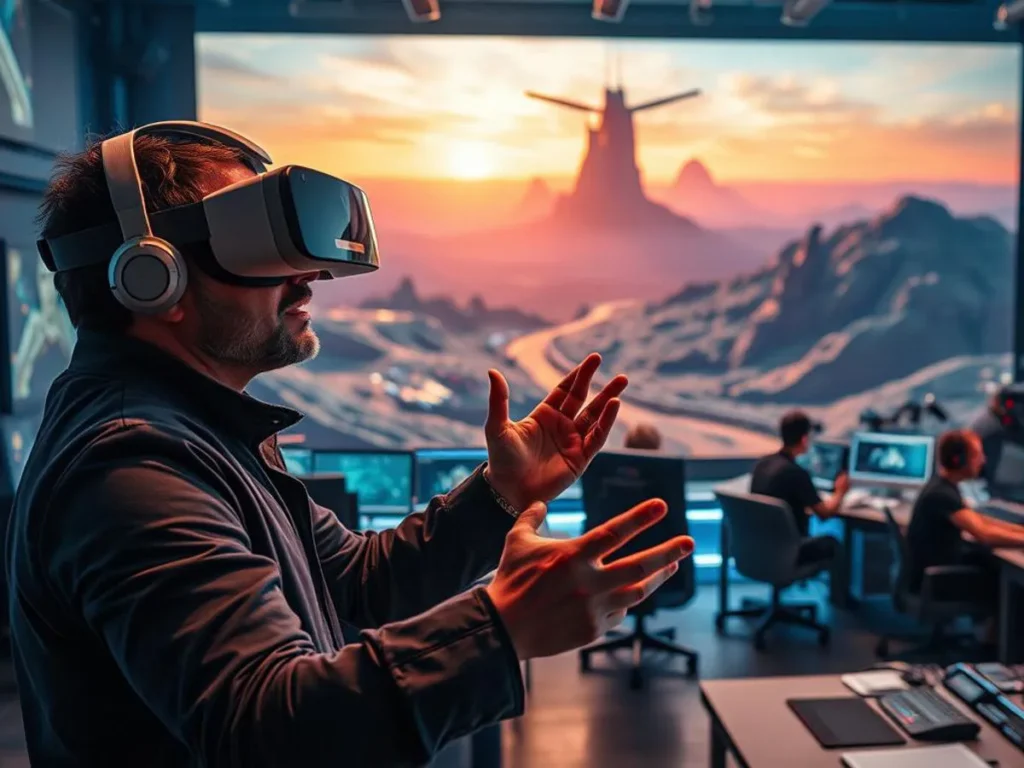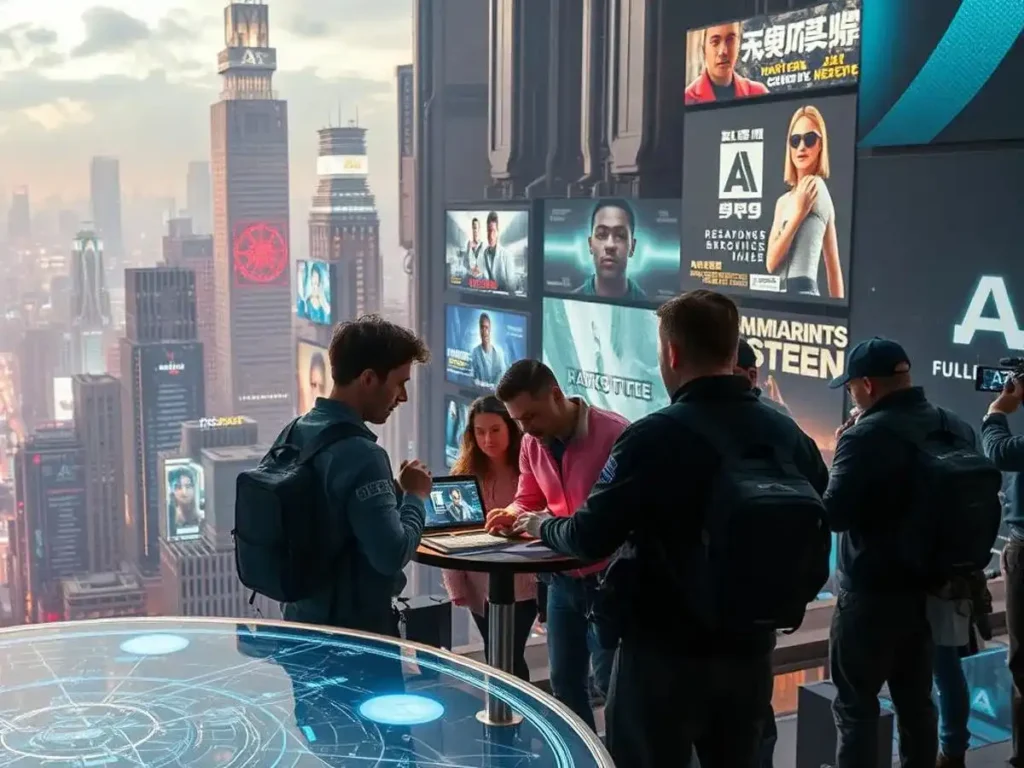Recent advancements have enabled the production of AI-Generated Movies, raising questions about the future of filmmaking.

As this technology continues to evolve, it is likely to have a profound impact on the industry.
With the potential to change the way films are made, ai-generated content is becoming a topic of interest among industry professionals and enthusiasts alike.
The Evolution of Filmmaking Technology
Advances in technology have dramatically changed the filmmaking world, opening up new ways to tell stories. The shift from old-school methods to advanced digital tools has greatly improved film quality and creativity.
From Traditional Animation to CGI Revolution
Traditional animation was once the norm, requiring a lot of hard work to create each frame. The introduction of computer-generated storytelling brought a major change. It brought software that made complex animations and effects easier and more precise. This CGI revolution has allowed for stunning visuals that draw in viewers worldwide.

The Emergence of AI in Visual Storytelling
The latest leap in filmmaking tech is the use of machine learning films and artificial intelligence. AI helps in many production steps, from writing scripts to editing. This has led to more efficient and creative ways of telling stories through digital content creation.
As AI grows in visual storytelling, it promises to keep changing the industry. It’s an exciting time for both filmmakers and viewers.
What Are AI-Generated Movies?
These movies are created through advanced algorithms and machine learning. They range from visual effects to entire narratives, opening up new creative avenues.
Defining the Concept and Scope
AI-generated movies span a wide range of applications in filmmaking. At its essence, AI content creation involves artificial intelligence in producing movie elements like scenes, characters, or scripts. This technology is versatile and applicable at various stages from pre-production to post-production.
Types of AI Involvement in Filmmaking
AI’s role in filmmaking can differ based on the desired level of automation and human input.
Fully Automated Production
In fully automated production, AI systems manage the entire filmmaking process without human involvement. This includes scriptwriting, scene creation, and editing. While it can cut down production time and costs, it currently lacks in creative nuance and emotional depth.
AI-Human Collaborative Creation
The AI-human collaborative creation model is a hybrid approach. Directors, writers, and editors work alongside AI to leverage its strengths in data analysis, pattern recognition, and automated tasks. This enhances the filmmaking process.
Current Capabilities and Limitations
AI-generated movies can produce high-quality visual effects and automate repetitive tasks. They can even generate script ideas. Yet, they struggle to replicate the emotional complexity and nuanced storytelling that human creators can achieve. The table below outlines the current capabilities and limitations of AI in filmmaking.
| Aspect | Current Capabilities | Limitations |
|---|---|---|
| Visual Effects | High-quality effects, automated rendering | May lack subtlety and human touch |
| Scriptwriting | Generating ideas, dialogue, and narrative structures | Emotional depth and originality can be limited |
| Storytelling | Analyzing trends, suggesting plot twists | Complex narratives and character development challenging |

The Technology Behind AI-Generated Movies
The technology behind AI-generated movies is complex, combining machine learning, natural language processing, and computer vision. It’s changing how we experience movies.
Machine Learning Algorithms for Visual Content
Machine learning algorithms are key in creating visual content for AI movies. They help make complex scenes and characters, cutting down production time and costs.
Generative Adversarial Networks (GANs)
They’re great for creating digital content for films.
Deep Learning Models
Deep learning models are vital for analyzing and creating complex visual patterns. They’re essential for machine-learning films with advanced visual effects.
Natural Language Processing for Scriptwriting
Natural Language Processing (NLP) is crucial for scriptwriting in AI movies. It helps create coherent and engaging stories. NLP algorithms analyze script data, making new scripts that fit the context and are creative.
Computer Vision and Scene Generation
Computer vision is vital for scene generation in AI movies. It analyzes visual data to recreate or generate new scenes. These scenes are visually stunning and fit the story, enhancing computer-generated storytelling.
This technology is revolutionizing the film industry. It’s making it possible to create complex, high-quality movies efficiently.
Pioneering Projects in AI Cinema
AI cinema is revolutionizing visual storytelling. The fusion of artificial intelligence in filmmaking has introduced groundbreaking and unconventional cinematic experiences.
Experimental Short Films Created by AI
AI has given birth to several experimental short films. These films showcase AI’s potential in storytelling and visual effects. They merge traditional filmmaking with AI-generated content, creating distinctive narratives.
AI has been instrumental in generating scripts, creating characters, and directing scenes in these short films. This has broadened the scope for filmmakers to explore various styles and genres.
Commercial Applications and Studio Experiments
Major studios are now incorporating AI into their productions. They use AI for script analysis, visual effects, and even predicting box office success. This integration is transforming the filmmaking process.
The table below highlights some of the key projects and their applications:
| Project | Application | Outcome |
|---|---|---|
| AI-generated Short Film | Script and Visual Effects | Unique narrative and visual style |
| Studio Experiment | Script Analysis and Box Office Prediction | Enhanced decision-making for productions |
These pioneering projects showcase AI’s versatility and potential in the film industry. They are setting the stage for future innovations in AI-powered entertainment.
The Creative Process: Human-AI Collaboration
Human-AI collaboration is transforming storytelling in cinema. It’s not just about adopting new tech; it’s about boosting creativity. AI tools help filmmakers explore new storytelling, visual effects, and cinematic experiences.
Directors Leveraging AI Tools
Directors are now using AI to analyze scripts, plan shots, and predict box office success. AI-driven analysis aids in making informed decisions on projects, from casting to cinematography. For example, AI can analyze audience reactions to scenes, helping refine editing choices.
AI in directing also leads to algorithm-driven movies. It assists in creating complex scenes that traditional techniques can’t achieve.
AI-Assisted Screenwriting and Story Development
AI is significantly impacting screenwriting and story development. AI-assisted screenwriting tools analyze successful scripts, identify patterns, and generate content. This collaboration between humans and AI brings innovative storytelling and fresh perspectives to smart technology movies.
Visual Effects and Post-Production Enhancement
In visual effects and post-production, AI is changing digital content creation. AI automates tasks like data management and colour correction, freeing artists to focus on creativity. It also generates complex visual effects, such as realistic crowds and detailed environments, enhancing the visual experience.
Impact on Traditional Film Industry Roles
AI-generated movies are changing the film industry, potentially altering traditional roles. The use of artificial intelligence in filmmaking is more than a technological leap. It’s a transformative force across the industry.
Changing Landscape for Actors
Actors face a significant shift with AI-generated content. Digital replicas and performance capture are becoming key, enabling filmmakers to recreate performances without needing the actor’s physical presence.
Digital Replicas and Performance Capture
Digital replicas create a digital copy of an actor, used to recreate their performance. This tech has been used to de-age actors or recreate performances after they’ve passed away.
Voice Synthesis and Character Creation
AI-driven voice synthesis is also impacting actors. It allows for the creation of synthetic voices for character creation or dubbing. This could change the demand for human voice actors in some areas.
New Dynamics for Directors and Producers
AI tools are used for script analysis, scene planning, and predictive analytics to forecast a film’s success.
Technical Crew Evolution in an AI-Driven Environment
The technical crew, including editors, cinematographers, and visual effects artists, are adapting to AI. Automated editing tools and AI-driven visual effects software are reshaping post-production.
| Industry Role | AI Impact | Potential Outcome |
|---|---|---|
| Actors | Digital replicas, voice synthesis | Changes in casting, potential for synthetic performances |
| Directors/Producers | Script analysis, predictive analytics | Enhanced decision-making, streamlined production |
| Technical Crew | Automated editing, AI-driven visual effects | Efficient post-production, new creative possibilities |
Economic Implications for Hollywood Studios
The rise of machine-learning films is poised to reshape the financial landscape of the film industry. Hollywood studios, embracing AI-generated content, will see profound shifts in production costs, efficiency, and distribution tactics.
Production Cost Analysis and Efficiency Gains
AI’s role in filmmaking promises significant cost reductions. Algorithm-driven movies diminish the need for pricey equipment, locations, and personnel. AI can craft backgrounds, create CGI characters, and streamline editing, enhancing production efficiency.
| Production Aspect | Traditional Filmmaking | AI-Generated Content |
|---|---|---|
| Visual Effects | High costs for CGI and special effects | Reduced costs through AI-generated effects |
| Location Shooting | Expensive location fees and logistics | Potential for AI-generated backgrounds |
| Editing | The time-consuming manual editing process | Faster editing with AI-assisted tools |
Emerging Business Models and Distribution Strategies
AI’s integration in filmmaking unveils new business models and distribution strategies. With digital content creation advancing, studios can innovate in audience engagement and monetization. This includes personalized content, interactive narratives, and new revenue channels through streaming.
As the film industry evolves with AI-generated movies, grasping these economic shifts is vital for studios to adapt and flourish in a dynamic environment.
Audience Reception and Market Analysis
AI-generated movies are ushering in a new era in entertainment, sparking debates on audience reception and market potential. As the film industry embraces AI technology, gauging consumer sentiments and the commercial success of these films is vital.
Consumer Attitudes Toward AI-Created Entertainment
Opinions on AI-created entertainment vary widely. Some fans are thrilled by the fresh narrative avenues opened by AI-powered entertainment. Others, though, question AI’s creative bounds. Studies show that acceptance hinges on the AI content’s quality and context.
As smart technology movies gain traction, viewers are starting to value their distinct experiences.
Box Office Potential and Streaming Platform Integration
The box office prospects of ai-generated movies are a hot topic in the industry. Some foresee AI content drawing in fresh viewers, while others worry about the backlash against “non-human” creativity. Streaming platforms are set to be key in AI movie distribution, offering a safe space to gauge audience reactions.
As the market shifts, AI-powered entertainment is expected to carve out its own space. This could lead to innovative business models and income avenues for studios and creators.
Ethical and Legal Challenges
The integration of AI in movie production has highlighted a range of ethical and legal concerns. As AI-generated content gains traction, the film industry must navigate these issues. This ensures a smooth transition into this new era of filmmaking.
Copyright and Intellectual Property Concerns
One major legal challenge is figuring out who owns AI-generated content. It’s unclear whether copyright should be attributed to the AI, its developers, or the users.
Key Considerations:
| Aspect | Traditional Filmmaking | AI-Generated Content |
|---|---|---|
| Copyright Ownership | Human creators/authors | Unclear – AI, developers, or users? |
| Creative Control | Humans have full control | AI algorithms play a significant role |
| Legal Framework | Established laws and precedents | New laws and regulations are needed |
Authenticity, Artistic Value, and Creative Attribution
The rise of AI in filmmaking raises ethical questions about authenticity and artistic value. There’s a risk that human creativity’s value could be diminished if AI content is not properly credited or seen as less valuable.
The industry must find a balance between AI’s innovative potential and the preservation of human artistic integrity.
Industry Regulation and Emerging Standards
To tackle these challenges, the industry needs regulation and new standards. This includes setting guidelines for AI use in filmmaking, clarifying copyright laws, and protecting human creators’ rights while encouraging innovation.
By addressing these challenges proactively, the film industry can embrace AI-generated content responsibly and innovatively.
The Future of AI-Generated Movies
Machine learning algorithms are becoming more advanced, opening up vast possibilities for AI-generated movies. The film industry is set for significant transformations as AI technology progresses.
Expert Predictions and Industry Forecasts
Industry experts foresee AI’s pivotal role in filmmaking’s future. A recent report indicates a 30% increase in AI use in movie production over the next five years. This surge is fueled by AI’s efficiency and creativity in filmmaking.
| Year | AI Adoption in Filmmaking | Predicted Growth |
|---|---|---|
| 2023 | 20% | 25% |
| 2025 | 35% | 40% |
| 2030 | 60% | 70% |
Technological Advancements on the Horizon
Progress in machine learning and natural language processing will fuel the creation of more complex AI-generated content. AI can now produce realistic visual effects, develop intricate characters, and aid in scriptwriting.
The outlook for AI-generated movies is optimistic, with potential applications across genres from animation to live-action films. As technology evolves, we can anticipate even more innovative AI applications in the film industry.
Table of Contents
Conclusion: Redefining Creativity in the Digital Age
The film industry is on the brink of a revolution, with AI-generated movies at the forefront. We’ve seen how artificial intelligence is transforming filmmaking, making it a reality today. AI is now a crucial tool, from scriptwriting to post-production, creating AI-powered entertainment that was once unimaginable.
The rise of smart technology movies is changing storytelling, enabling more complex and visually stunning narratives. As artificial intelligence cinema advances, it’s evident that filmmaking’s future will blend human creativity with machine intelligence.
This collaboration is set to open up new possibilities in cinema. The industry’s ongoing adaptation and innovation are clear. The digital age is reshaping creativity, and AI is leading this transformation.

